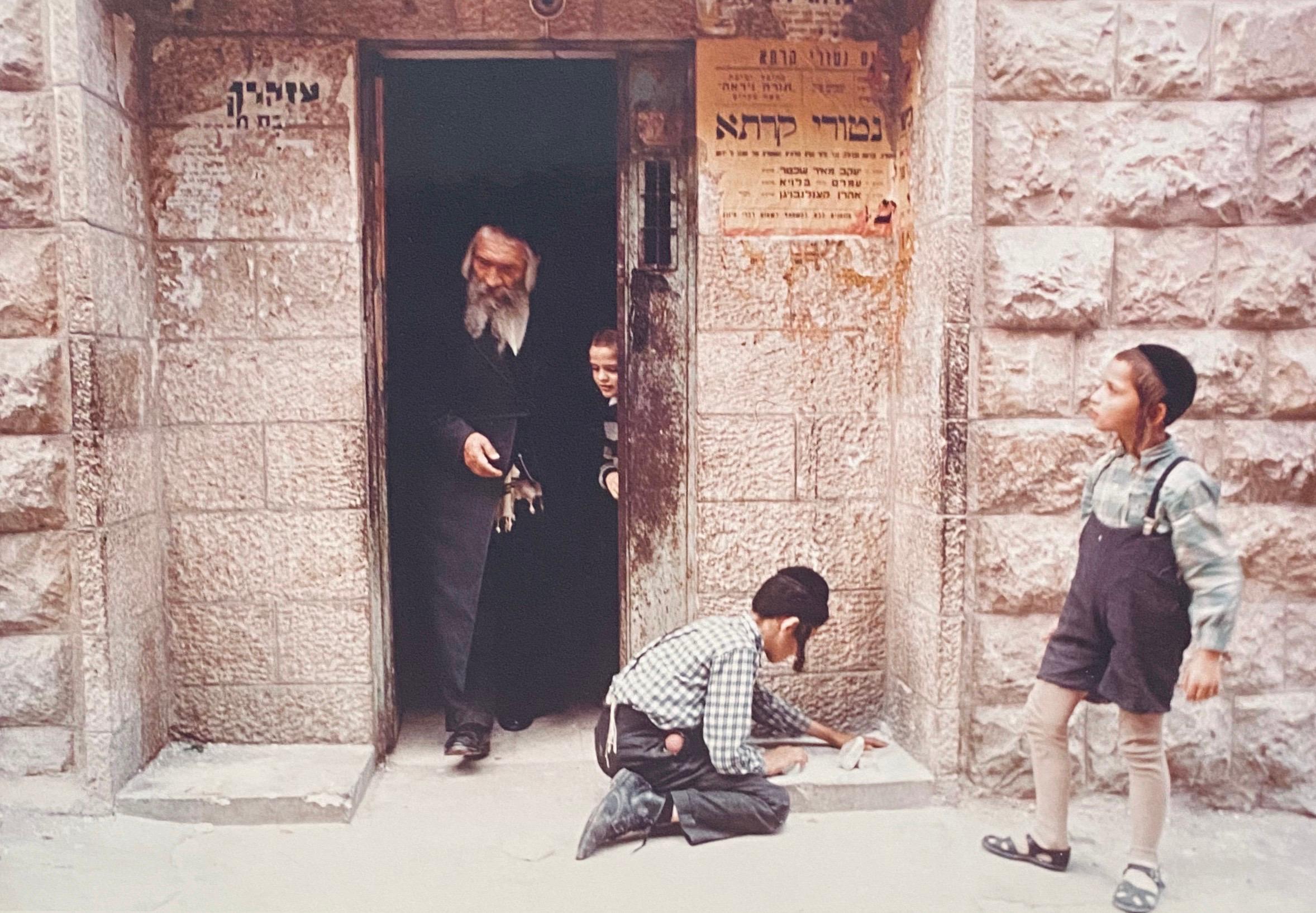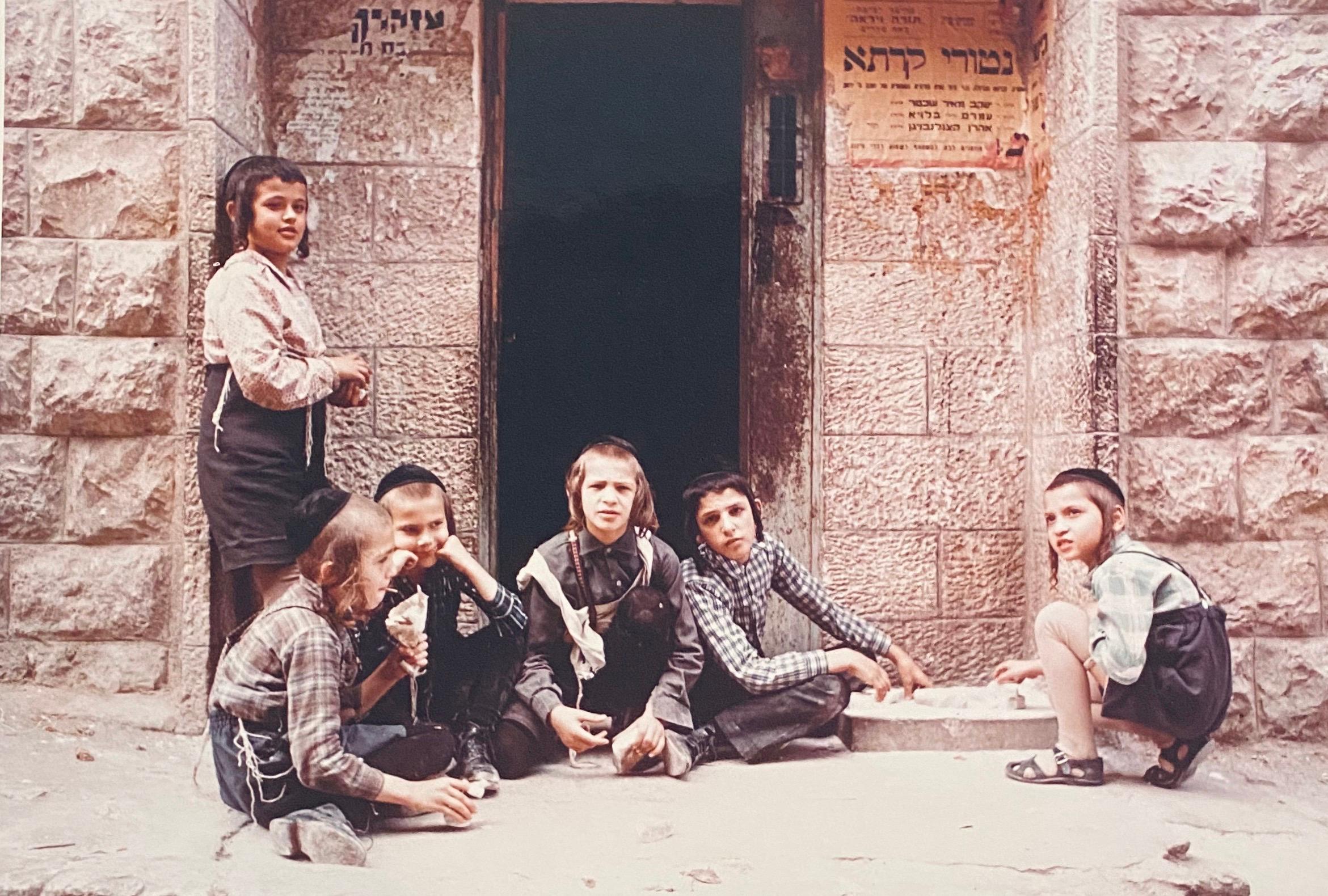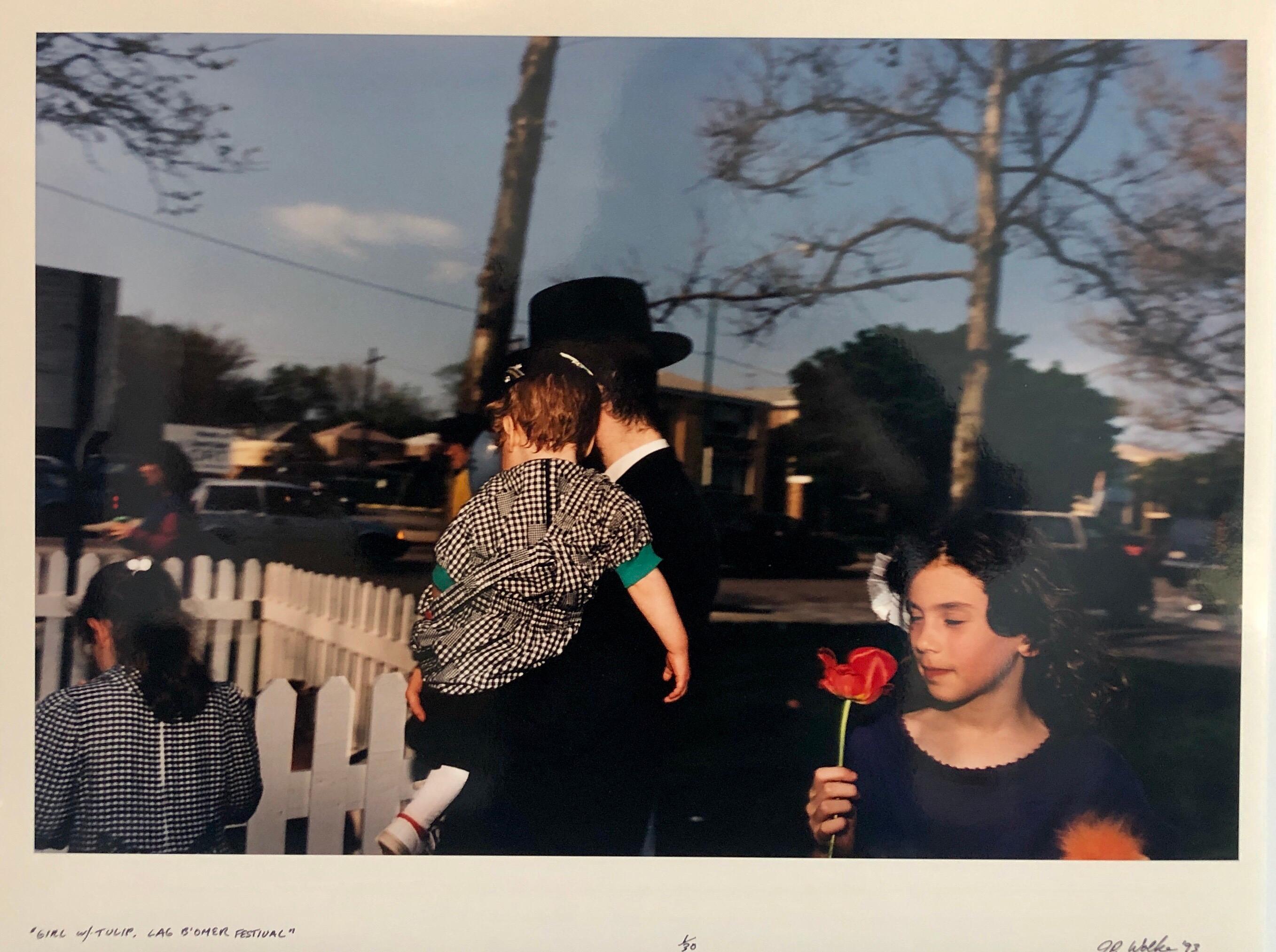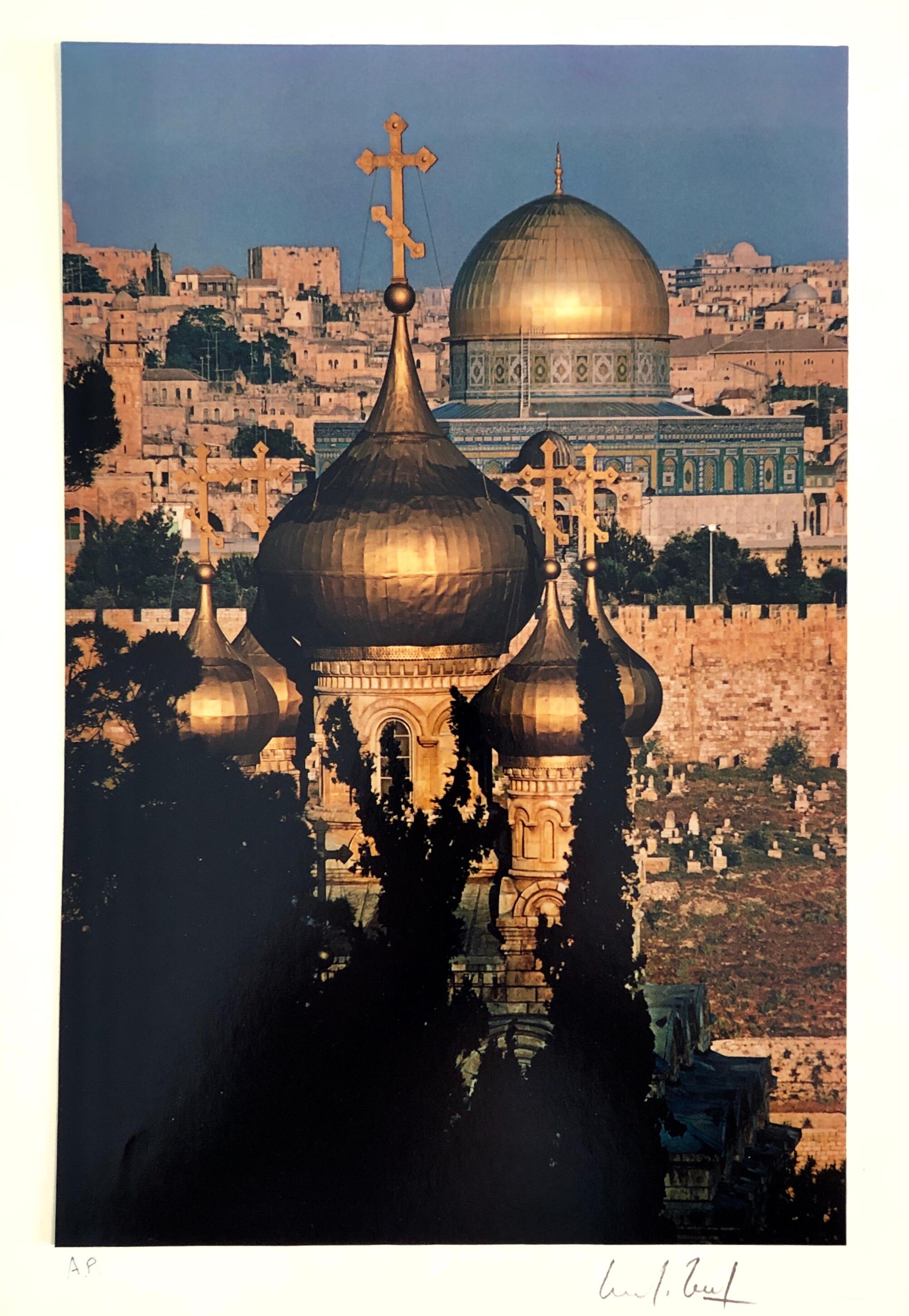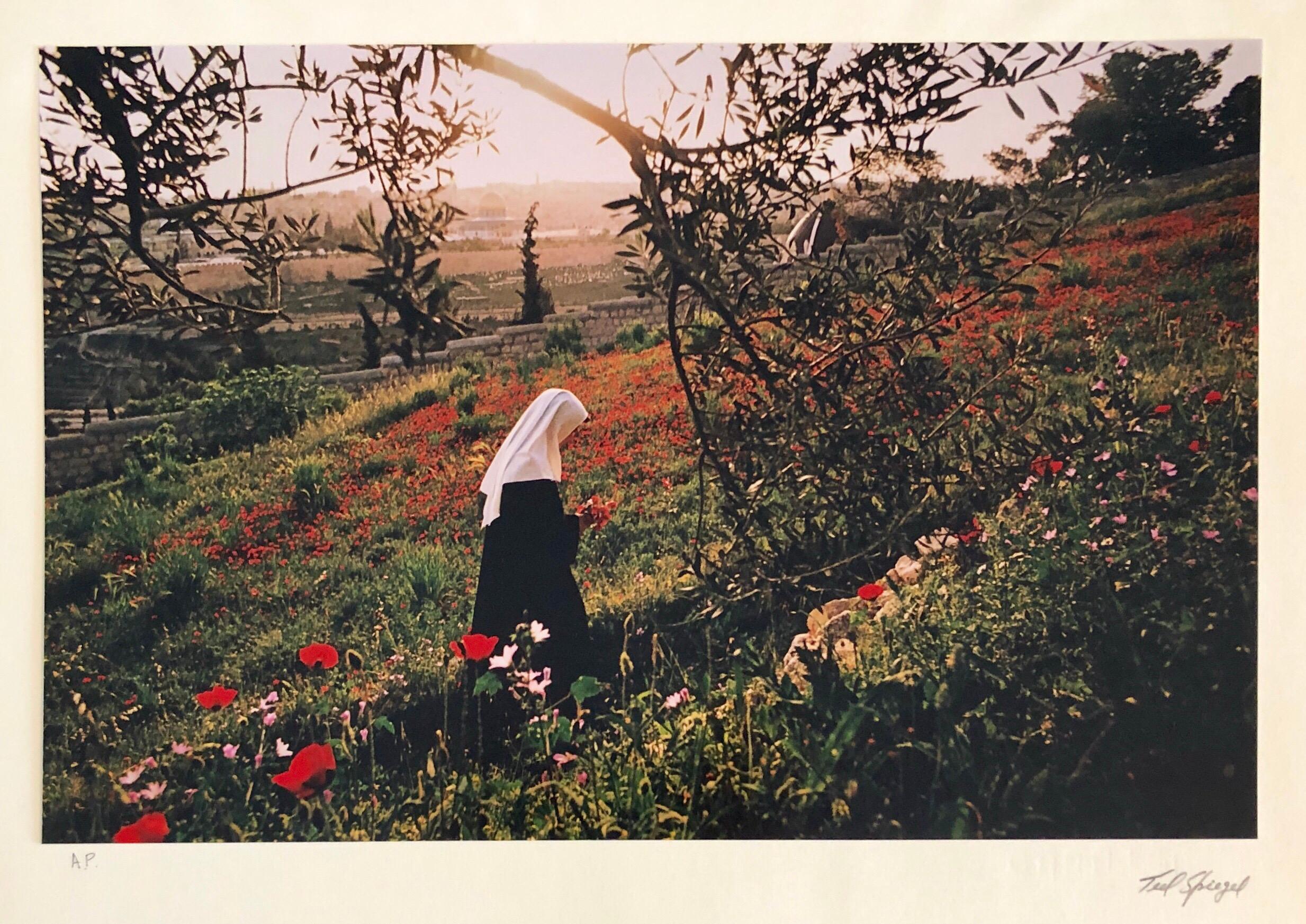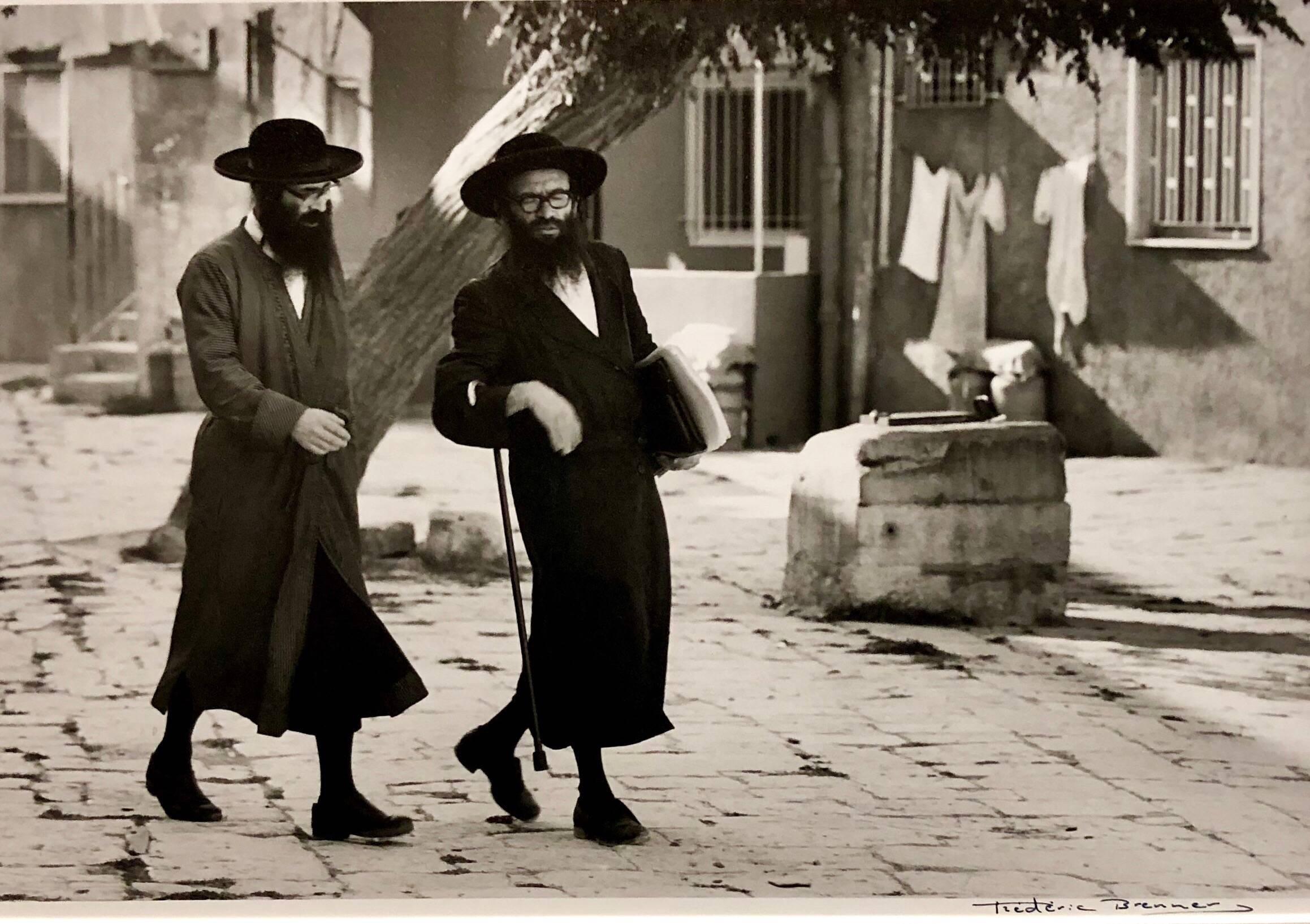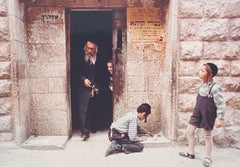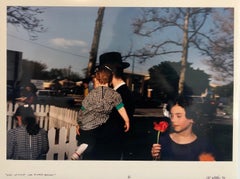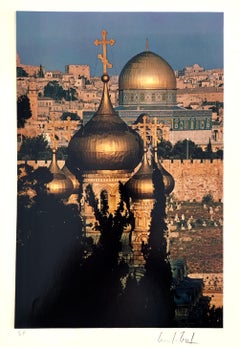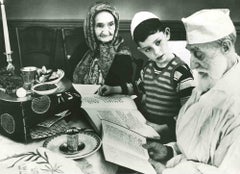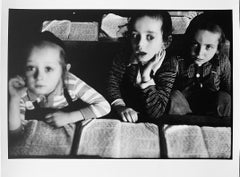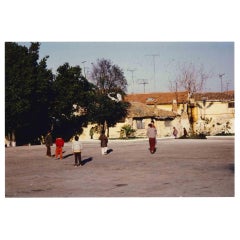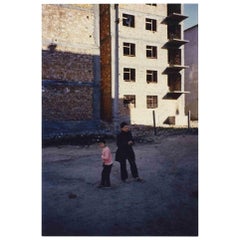Items Similar to Colored Photograph Of Nerturei Karta Children Playing
Want more images or videos?
Request additional images or videos from the seller
1 of 11
UnknownColored Photograph Of Nerturei Karta Children Playing
$650
£492.52
€564.14
CA$920.65
A$1,004.64
CHF 526.95
MX$12,201.74
NOK 6,581.93
SEK 6,220.26
DKK 4,210.51
About the Item
Neturei Karta (Jewish Babylonian Aramaic: נָטוֹרֵי קַרְתָּא nāṭōrē qarṯā, literally "Guardians of the City") is a religious group of Haredi Jews, formally created in Jerusalem, British Mandate of Palestine, in 1938, splitting off from Agudas Yisrael. Neturei Karta opposes Zionism and calls for a "peaceful dismantling" of the State of Israel, in the belief that Jews are forbidden to have their own state until the coming of the Jewish Messiah and that the state of Israel is a rebellion against god. While the Neturei Karta describe themselves as true traditional Jews, the more secular US-based Jewish Anti-Defamation League has described them as "the farthest fringes of Judaism".
In Israel some members also pray at affiliated beit midrash, in Jerusalem's Meah Shearim neighborhood and in Ramat Beit Shemesh Bet. Neturei Karta states that no official count of the number of members exists. The Jewish Virtual Library puts their numbers at 5,000, while the Anti-Defamation League estimates that fewer than 100 members of the community take part in anti-Israel activism. According to the Anti-Defamation League, members of Neturei Karta have a long history of "extremist statements" and support for notable anti-Zionists and Islamists.
According to the US branch Neturei Karta:
"The name Neturei Karta is a name usually given to those people who regularly pray in the Neturei Karta synagogues (Torah Ve'Yirah Jerusalem, Torah U'Tefillah London, Torah U'Tefillah NY, Beis Yehudi Upstate NY, etc.), study in or send their children to educational institutions run by Neturei Karta, or actively participate in activities, assemblies or demonstrations called by the Neturei Karta".
Originally the organization was called Chevrat HaChayim (Society of Life); however this name was quickly supplanted in favor of the name Neturei Karta.
The name Neturei Karta literally means "Guardians of the City" in Aramaic and is derived from a narrative on page 76c of Tractate Hagigah in the Jerusalem Talmud. There it is related that Rabbi Judah haNasi sent two rabbis on a tour of inspection:
In one town they asked to see the "guardians of the city" and the city guard was paraded before them. They said that these were not the guardians of the city but its destroyers, which prompted the citizens to ask who, then, could be considered the guardians. The rabbis answered, "The scribes and the scholars," referring them to Tehillim (Psalms) Chapter 127.
It is this role that Neturei Karta see themselves as fulfilling by defending what they believe is "the position of the Torah and authentic unadulterated Judaism."
Generally, members of Neturei Karta are descendants of Hungarian Jews and Lithuanian Jews who were students of the Gaon of Vilna (known as Perushim) who had settled in Jerusalem in the early nineteenth century. In the late nineteenth century, their ancestors participated in the creation of new neighborhoods outside the city walls to alleviate overcrowding in the Old City, and most are now concentrated in the neighborhood of Batei Ungarin and the larger Meah Shearim neighborhood.
At the time, they were vocal opponents to the new political ideology of Zionism that was attempting to assert Jewish sovereignty in Ottoman-controlled Palestine. They resented the new arrivals, who were predominantly non-religious, while they asserted that Jewish redemption could be brought about only by the Jewish messiah.
Members of Neturei Karta at the Quds Day protests in Berlin 2014
Neturei Karta was founded by Rabbi Amram Blau and Rabbi Aharon Katzenelbogen. Rabbi Blau was a native of Meah Shearim in Jerusalem and was active in the Agudat Israel during the British Mandate era. However, by the 1930s, the Aguda began to adopt a more compromising and accommodationist approach to the Zionist movement. This caused Rabbi Blau to split with the Aguda in 1937 and cofound Chevrat HaChayim (with Rabbi Katzenelbogen), which was soon to be known thereafter as Neturei Karta.
Other Orthodox Jewish movements, including some who oppose Zionism, have denounced the activities of the radical branch of Neturei Karta. According to The Guardian, "[e]ven among Haredi, or ultra-Orthodox circles, the Neturei Karta are regarded as a wild fringe". Neturei Karta is sometimes confused with Satmar, due to both being anti-Zionist; however, they are separate groups and have had disagreements. For example, Satmar criticized Neturei Karta for attending a 2006 holocaust revisionist conference in Iran. Neturei Karta asserts that the mass media deliberately downplays their viewpoint and makes them out to be few in number. Their protests in America are usually attended by, at most, a few dozen people. In Israel, the group's protests typically attract several hundred participants, depending on the nature of the protest and its location.
In July 2013, the Shin Bet arrested a 46-year-old member of Neturei Karta for allegedly attempting to spy on Israel for Iran. As part of a plea deal, the man was sentenced to 41⁄2 years in prison. Neturei Karta has denied that he had ever been a member of their group.
Neturei Karta's website states that its members "frequently participate[s] in public burning of the Israeli flag." On the Jewish holiday of Purim, Neturei Karta members have routinely burned Israeli flags in celebrations in cities such as London, Brooklyn and Jerusalem.
While many in Neturei Karta chose to simply ignore the State of Israel, this has become more difficult. Some took steps to condemn Israel and bring about its eventual dismantling until the coming of the Messiah. Chief among these was Moshe Hirsch, leader of an activist branch of Neturei Karta, who served in Yasser Arafat's cabinet as Minister for Jewish Affairs.
Neturei Karta stress what is said in the mussaf Shemona Esrei ("The Standing Prayer") of Yom Tov, that because of their sins, the Jewish people went into exile from the Land of Israel ("umipnei chatoeinu golinu meiartzeinu"). Additionally, they maintain the view – based on the Babylonian Talmud– that any form of forceful recapture of the Land of Israel is a violation of divine will. They believe that the restoration of the Land of Israel to the Jews should happen only with the coming of the Messiah, not by self-determination.
Neturei Karta believe that the exile of the Jews can end only with the arrival of the Messiah, and that human attempts to establish Jewish sovereignty over the Land of Israel are sinful. In Neturei Karta's view, Zionism is a presumptuous affront against God. Chief among their arguments against Zionism is the Talmudic concept of the so-called Three Oaths, extracted from the discussion of certain portions of the Bible. It states that a pact consisting of three oaths was made between God, the Jewish people, and the nations of the world, when the Jews were sent into exile. One provision of the pact was that the Jews would not rebel against the non-Jewish world that gave them sanctuary; a second was that they would not immigrate en masse to the Land of Israel. In return, the gentile nations promised not to persecute the Jews. By rebelling against this pact, they argued, the Jewish people were engaging in rebellion against God.
The Neturei Karta synagogues follow the customs of the Gaon of Vilna, due to Neturei Karta's origin within the Lithuanian rather than Hasidic branch of ultra-Orthodox Judaism. Neturei Karta is not a Hasidic but a Litvish group; they are often mistaken for Hasidim because their style of dress (including a shtreimel on Shabbos) is very similar to that of Hasidim. This style of dress is not unique to Neturei Karta, but is also the style of other Jerusalem Litvaks, such as Rabbi Yosef Sholom Eliashiv and his followers. Furthermore, Shomer Emunim, a Hasidic group with a similar anti-Zionist ideology, is often bundled together with Neturei Karta. Typically, the Jerusalem Neturei Karta will keep the customs of the "Old Yishuv" of the city of Jerusalem even when living outside of Jerusalem or even when living abroad, as a demonstration of their love for and connection to the Holy Land.
- Dimensions:Height: 11 in (27.94 cm)Width: 14 in (35.56 cm)
- Medium:
- Period:
- Condition:Minor Toning. Please see photos.
- Gallery Location:Surfside, FL
- Reference Number:1stDibs: LU38215377962
About the Seller
4.9
Platinum Seller
Premium sellers with a 4.7+ rating and 24-hour response times
Established in 1995
1stDibs seller since 2014
1,810 sales on 1stDibs
Typical response time: 1 hour
- ShippingRetrieving quote...Shipping from: Surfside, FL
- Return Policy
Authenticity Guarantee
In the unlikely event there’s an issue with an item’s authenticity, contact us within 1 year for a full refund. DetailsMoney-Back Guarantee
If your item is not as described, is damaged in transit, or does not arrive, contact us within 7 days for a full refund. Details24-Hour Cancellation
You have a 24-hour grace period in which to reconsider your purchase, with no questions asked.Vetted Professional Sellers
Our world-class sellers must adhere to strict standards for service and quality, maintaining the integrity of our listings.Price-Match Guarantee
If you find that a seller listed the same item for a lower price elsewhere, we’ll match it.Trusted Global Delivery
Our best-in-class carrier network provides specialized shipping options worldwide, including custom delivery.More From This Seller
View AllColored Photograph Of Nerturei Karta Children Playing
Located in Surfside, FL
Neturei Karta (Jewish Babylonian Aramaic: נָטוֹרֵי קַרְתָּא nāṭōrē qarṯā, literally "Guardians of the City") is a religious group of Haredi Jews, formally created in Jerusalem, Briti...
Category
Late 20th Century Color Photography
Materials
Photographic Paper
Colored Photograph Of Nerturei Karta Children Playing
Located in Surfside, FL
Neturei Karta (Jewish Babylonian Aramaic: נָטוֹרֵי קַרְתָּא nāṭōrē qarṯā, literally "Guardians of the City") is a religious group of Haredi Jews, formally created in Jerusalem, Briti...
Category
Late 20th Century Color Photography
Materials
Photographic Paper
Lag Baomer Signed Vintage Color Photograph Chicago Judaica Photo Chabad J Wolke
By Jay Wolke
Located in Surfside, FL
This is from a series done about the Habad Hasidic Jewish community in Chicago. This is from the holiday Lag Baomer.
Jay Wolke lives and works in Chicago, Illinois. He has had solo exhibitions at the Art Institute of Chicago, the St. Louis Art Museum, Harvard University and the California Museum of Photography. His photographs are in the permanent collections of the Museum of Modern Art, New York, the Whitney Museum of American Art, New York, the Art Institute of Chicago and the San Francisco Museum of Modern Art. Three monographs of his work have been published: All Around the House: Photographs of American-Jewish Communal Life (Art Institute of Chicago, 1998), Along the Divide: Photographs of the Dan Ryan Expressway (Center for American Places, 2004) and Architecture of Resignation: Photographs from the Mezzogiorno (Center for American Places, 2011). Kehrer Verlag will publish his fourth monograph, Same Dream Another Time, in 2017.
Wolke received his B.F.A. in Printmaking / Illustration at Washington University, St. Louis, and an M.S. in Photography at the Institute of Design, Illinois Institute of Technology, Chicago. Since 1981 he has taught photography and art at various universities. From 1992-1999 he was Coordinator of Graduate Documentary Photography at the Institute of Design (IIT). In 1999-2000 he was Head of Art and Graduate Studies at Studio Art Centers International, Florence, Italy. He is currently a Professor of Photography at Columbia College Chicago, where he also served as Chair of the Art and Design Department from 2000-05 and again from 2008-14. Wolke has received grants and awards from the National Endowment for the Arts, the Illinois Arts Council, Focus Infinity Fund and the Ruttenberg Arts Foundation. His photographs have appeared in numerous publications including Geo France, New York Times Magazine, Financial Times Magazine, Village Voice, Exposure and Architectural Record.
SELECT SOLO EXHIBITIONS
2015 Mostre Marte, Salerno, Italy, “Architecture of Resignation”
2014 PrimoPiano Gallery, Naples, Italy, “Architecture of Resignation”
2014 Foundation Studio Marangoni, Florence, Italy, “re-Located”
2014 Ralph Arnold Gallery, Loyola University, Chicago, “re-Located”
2013 Spertus Institute, Chicago, “All Around the House”
2012 University of Indiana Northwest Savanna Center, “Architecture of Resignation”
2010 Sheldon Arts Galleries, St. Louis, MO, “Architecture of Resignation”
2007 California Museum of Photography, Riverside, “Architecture of Resignation”
2006 St. Xavier University SXU Gallery, Chicago, “Architecture of Resignation”
2005 Schneider Gallery, Chicago, “Architecture of Resignation”
2005 City Gallery, Chicago Department of Cultural Affairs, “Along the Divide”
2002 Foundation Studio Marangoni, Florence, Italy, “Architecture of Resignation”
2002 St. Louis Art Museum, "All Around the House"
2000 Comunita Ebraica Salle Servi, Florence , Italy, “All Around the House”
1998 Art Institute of Chicago, "All Around the House"
1995 Harvard University, Carpenter Center, Cambridge, MA, "A Jewish View"
1994 Quad City Arts Center, Rock Island, IL "Temporary Usage"
1993 Northlight Gallery, Arizona State University, Tempe, "Temporary Usage"
1992 OK Harris Gallery, New York, NY, " Photographing American Dream Cities"
1991 Mid-Town Y Photography Gallery, New York, NY, "American Dream Cities”
1988 Portland School of Art, Portland, ME, "Las Vegas Portraits"
1987 Museum of Contemporary Photography, Chicago, IL, " Vegas Portraits"
1985 Chicago Historical Society, “Dan Ryan Project”
SELECT GROUP EXHIBITIONS
2016 Le Murate, Florence, Italy, “Arno Collective Imaginary” w. Massimo Vitali, Arno
Minkkinen
2015 Palazzo Reale, Milan, Italy, “Henri Cartier-Bresson e gli altri. I grandi fotografi e
l’Italia”,
2014 Pitzer College Art Galleries, Claremont, CA, “Racial Imaginary”
2014 Black Box Gallery, Portland, OR, “Architecture, Landscape”
2014-15 Millennium Park Foundation, Chicago, “An Anatomy in Photographs”
2012 Chicago Cultural Center, “Industry of the Ordinary: 2003–2013”
2009 David Weinberg Gallery, Chicago, “Social Landscapes”
2009 Packer Schopf Gallery, Chicago, “39 Verbs”
2009 University of St. Francis, “The Night Hope Won”
2008-09 Chicago Cultural Center, “Made In Chicago: Photographs from Bank of America
Collection”
2006 David Winton Bell Gallery, Brown University, Providence, "7 Documentarians:
Berenic Abbott, Walker Evans, Larry Clark, Jim Dow, Danny Lyon, Garry Winogrand,
Jay Wolke"
2006 Art Institute of Chicago. “Darkroom to Digital”
2005 Fort Worth Community Arts Center, “Cattle Drive”
2001 Illinois Art Gallery, “The Land Around Us”
1998 Carol Ehlers Gallery, Chicago, "Chicago Streets"
1996 Museum of Contemporary Photography, Chicago, "In Focus"
1995 Madison Arts Center, "Photography from Wisconsin, Minnesota, Illinois"
1994 Chicago Cultural Center, "Broad Spectrum"
1991 ARC Gallery, Chicago, "National Exposure"
1989 Art Institute of Chicago, "The City Inside and Out"
1989 Chicago Historical Society, "Changing Chicago, Public Diversions"
1988 Illinois State Museum, Springfield, "Lenscapes"
1987 Everson Museum, Syracuse, NY; Nabisco Corp., NJ; Fay Gold Gallery, Atlanta, GA
"American Interiors", traveling exhibit curated Lieberman/Saul Gallery, NY
1986 National Endowment for the Arts/ Midwest Arts Alliance, national traveling
1985 University of Wisconsin, Milwaukee, "New Color Photography"
1985 Society for Cont Photography, Morgan Gallery, Kansas City, MO, "Photo '85"
1984 Art...
Category
1990s American Modern Color Photography
Materials
C Print
Vintage Color Photograph Old City Jerusalem Temple Mount Marc Riboud Photo 1973
By Marc Riboud
Located in Surfside, FL
This is for one Photograph from the portfolio entitled "Jerusalem: City of Mankind," The mounting is 14 X 17 inches. the actual photo measurement is between 9.25 X 14 to 10.5 X 13.5 inches (22.9 X 35.6 to 26.7 X 34.3 cm.) This is hand signed and editioned in pencil, on mount recto; and stamped on the reverse with photographers name and copyright info. In a folding jacket with a printed credit and title.
The first copy was awarded to the President of the United States, the second to the President of the State of Israel, the third to the Mayor of Jerusalem and the fourth to the Baron Edmond de Rothschild. Rare Cornell Capa and Baron Edmond De Rothschild “Jerusalem: City Of Mankind” Photo Album 1973. It has been produced by the international fund for concerned photography, INC, New York for the women’s division of the American Friends of the Israel Museum, New York.
15 copied were reserved for participating photographers.
Color prints are made by dye transfer process from original transparencies and black and white enlargements are made from original negatives under the photographers supervision.
Design and production – Arnold Skolnick / Bhupendra Karia.
Color prints by Berkey K & L Custom Services INC, New York.
Black and white prints by Igor Bakht
Werner Braun – Moonrise over the Knesset
Robert Burroughs – At the Western Wall.
Cornell Capa – View from the Israel Museum sculpture garden.
Leonard Freed – Reading from Sephardic Torah scrolls.
Ernst Haas – In the Arab quarter, Old City.
Charles Harbutt – Easter, Holy fire.
Ron Havilio – Wallscape.
Bhupendra Karia – Midday prayers, Al Aqsa grounds.
Marc Riboud – Ecumenical landscape Billy rose garden, Israel museum.
Ted Spiegel – Benedictine nun, Mount of Olives.
Micha Bar-Am – Via Dolorosa on Friday.
Marc Riboud (French: 1923 – 2016) was a French photographer, best known for his extensive reports on the Far East: The Three Banners of China, Face of North Vietnam, Visions of China, and In China.
Riboud was born in Saint-Genis-Laval and went to the lycée in Lyon. He photographed his first picture in 1937, using his father's Vest Pocket Kodak camera. As a young man during World War II, he was active in the French Resistance, from 1943 to 1945. After the war, he studied engineering at the École Centrale de Lyon from 1945 to 1948.
He moved to Paris where he met Henri Cartier-Bresson, Robert Capa, and Chim, David Seymour, the founders of Magnum Photos. By 1953 he was a member of the organization. His ability to capture fleeting moments in life through powerful compositions was already apparent, and this skill was to serve him well for decades to come.
Over the next several decades, Riboud traveled around the world. In 1957, he was one of the first European photographers to go to China, and in 1968, 1972, and 1976, Riboud made several reportages on North Vietnam. Later he traveled all over the world, but mostly in Asia, Africa, the U.S. and Japan. Riboud has been witness to the atrocities of war (photographing from both the Vietnam and the American sides of the Vietnam War), and the apparent degradation of a culture repressed from within (China during the years of Chairman Mao Zedong's Cultural Revolution). In contrast, he has captured the graces of daily life, set in sun-drenched facets of the globe (Fès, Angkor, Acapulco, Niger, Bénarès, Shaanxi), and the lyricism of child's play in everyday Paris. In 1979 Riboud left the Magnum agency.
Riboud's photographs have appeared in numerous magazines, including Life, Géo, National Geographic, Paris Match, and Stern. He twice won the Overseas Press Club Award, received the Lifetime Achievement Award at the 2009 Sony World Photography Awards and has had major retrospective exhibitions at the Musée d'Art Moderne de la Ville de Paris and the International Center of Photography in New York.
Riboud was made an Honorary Fellow of the Royal Photographic Society in 1998.
One of Riboud's best known images is Eiffel Tower Painter, taken in Paris in 1953. It depicts a man painting the tower, posed like a dancer, perched between the metal armature of the tower. Below him, Paris emerges from the photographic haze. Lone figures appear frequently in Riboud's images. In Ankara, a central figure is silhouetted against an industrial background, whereas in France, a man lies in a field. The vertical composition emphasizes the landscape, the trees, sky, water and blowing grass, all of which surround but do not overpower the human element.
An image taken by Riboud on 21 October 1967, entitled "The Ultimate Confrontation: The Flower and the Bayonet," is among the most celebrated anti-war pictures. Shot in Washington, D.C. where thousands of anti-war activists had gathered in front of the Pentagon to protest against America's involvement in Vietnam.
Select Exhibitions
1958 Photographs From The Museum Collection (Museum of Modern Art, New York)
1959 30th Anniversary Special Installation - Towards the "New" Museum (Museum of Modern Art)
1960 Photographs...
Category
1960s Modern Color Photography
Materials
Photographic Paper, C Print, Color
Vintage Color Photograph Nun, Mount Olives, Jerusalem Museum Ted Spiegel Photo
Located in Surfside, FL
This is a vintage Ted Spiegel photo of a Benedictine Nun, Mount of Olives, Jerusalem. Hand signed and editioned A/P.
This is for one Photograph from the portfolio entitled "Jerusalem: City of Mankind," The mounting is 14 X 17 inches. the actual photo measurement is between 9.25 X 14 to 10.5 X 13.5 inches (22.9 X 35.6 to 26.7 X 34.3 cm.) This is hand signed and editioned in pencil, on print mount recto; and stamped on the reverse with photographers name and copyright info. In a folding jacket with a printed credit and title. The red title sheet is just here for provenance and reference and is not included in this sale.
The first copy was awarded to the President of the United States, the second to the President of the State of Israel, the third to the Mayor of Jerusalem and the fourth to the Baron Edmond de Rothschild. Rare Cornell Capa and Baron Edmond De Rothschild “Jerusalem: City Of Mankind” Photo Album 1973. It has been produced by the international fund for concerned photography, INC, New York for the women’s division of the American Friends of the Israel Museum, New York.
15 copied were reserved for participating photographers.
Color prints are made by dye transfer process from original transparencies and black and white enlargements are made from original negatives under the photographers supervision.
Design and production – Arnold Skolnick / Bhupendra Karia.
Color prints by Berkey K & L Custom Services INC, New York.
Black and white prints by Igor Bakht
Werner Braun – Moonrise over the Knesset
Robert Burroughs – At the Western Wall.
Cornell Capa – View from the Israel Museum sculpture garden.
Leonard Freed – Reading from Sephardic Torah scrolls.
Ernst Haas – In the Arab quarter, Old City.
Charles Harbutt – Easter, Holy fire.
Ron Havilio – Wallscape.
Bhupendra Karia – Midday prayers, Al Aqsa grounds.
Marc Riboud – Ecumenical landscape Billy rose garden, Israel museum.
Ted Spiegel – Benedictine nun, Mount of Olives.
Micha Bar-Am – Via Dolorosa on Friday.
An accomplished photojournalist with more than 50 years of experience, Ted Spiegel has
covered assignments across the globe, but like the 19th-century artists of the famed Hudson
River School, he's made the Hudson River Valley the focus of much of his life's work.
Spiegel's love of the landscape and positive attitude infuse all his images. His January 1978 assignment for National Geographic magazine was a color photo essay on the Hudson River Valley. He has produced 15 other photo essays for National Geographic magazine on a variety of subjects, and has also produced several picture books on such topics as the Hudson River Valley, Saratoga and West Point. He also did a celebrated series of photos of John F Kennedy one of which was selected for the JFK USA postal stamp.
Speigel’s biography on the National Geographic website espouses his zest for his home: “He’s covered assignments across the globe, but like the 19th-century artists of the famed Hudson River School, he’s made the Hudson River Valley the focus of much of his life’s work.”
It also notes that he uses photography as a medium to encourage appreciation and respect for the environment’s beauty: “Spiegel’s love of the landscape and positive attitude infuse all his images, [and he] sees his landscape photography as a way to make people aware of the beauty in nature and a way to, in turn, encourage people to help protect and save the environment.” Photographers, like seeds in a rich environment, take root, grow and prosper. For Ansel Adams, the place was the West Coast -- Carmel, Calif., and Yosemite National Park. For Ted Spiegel, it is the Hudson River Valley -- Bear Mountain...
Category
1970s Modern Color Photography
Materials
Photographic Paper, C Print, Color
Dans le Quartier Hongrois de Mea Shearim, Jerusalem Vintage Silver Gelatin Print
By Frederic Brenner
Located in Surfside, FL
Meah Shearim photograph of Torah scholars. Rabbis in Jerusalem. Photo of Hungarian quarter.
Frédéric Brenner (born 1959) is a French photographer known for his documentation of Jewish communities around the world. His work has been exhibited internationally, among others, at the International Center of Photography in New York, the Musée de l'Élysée in Lausanne, Rencontres d'Arles in Arles, the Brooklyn Museum in New York, and the Joods Historisch Museum in Amsterdam.
Brenner was born in Paris and grew up in France. In 1981, Brenner received a B.A. in French Literature and Social Anthropology from the Paris-Sorbonne University. He went on to study at the École des hautes études en sciences sociales and received a M.A. in Social Anthropology, also awarded by the Sorbonne.
Brenner is the recipient of the Niépce Prize and his book Diaspora: Homelands in Exile won the 2004 Visual Arts Award from the Jewish Book Council.
At age 19, Brenner began photographing Orthodox Jews in the Mea Shearim neighborhood of Jerusalem. Initially, he believed this was "authentic Judaism," but his approach quickly evolved into an exploration of the multiplicities of dissonant identities.
In 1981, Brenner began photographing Jewish communities around the world, exploring what it means to live and survive with a portable identity and how Jews adopted the traditions and manners of their home countries and yet remained part of the Jewish people. He spent 25 years chronicling the diaspora of the Jews across the world from Rome to New York, India to Yemen, Morocco to Ethiopia, Sarajevo to Samarkand. Brenner has published five books and directed three films. His work has been shown in museums and galleries around the world. He has been represented by Howard Greenberg Gallery in New York since 1990.
Brenner’s opus Diaspora: Homelands in Exile was published as a two-volume set of photographs and texts by HarperCollins in 2003 and appeared in four foreign editions. Diaspora was also a major exhibition, which opened in New York at the Brooklyn Museum in 2003 and traveled to nine other cities in America, Europe and Mexico. In reviewing the book, The New Yorker wrote: “Brenner's work—elegiac, celebratory, irreverent—transcends portraiture, representing instead a prolonged, open-ended inquiry into the nature of identity and heritage.” NPR's Robert Siegel has described Brenner's work as "a celebration of the diversity and complexity of diaspora."
In 2006, Brenner founded This Place, a collective photography project aimed at recontextualizing Israel from multiple perspectives. The photographers working on this project include Wendy Ewald, Martin Kollar, Josef Koudelka, Jungjin Lee...
Category
1970s Realist Black and White Photography
Materials
Silver Gelatin
You May Also Like
Jewish Holiday - American Vintage Photograph - Mid 20th Century
Located in Roma, IT
Jewish Holiday- American Vintage Photograph is an original black and white photograph realized in the U.S in the mid-20th Century in a series of American life in the 20th Century.
W...
Category
Mid-20th Century Modern Figurative Photography
Materials
Photographic Paper
Jewish Diaspora 1950s, Yeshiva Students New York, Black-and-White Photography
By Leonard Freed
Located in New york, NY
Yeshiva Students, New York City, 1954 by Leonard Freed is a black-and-white photograph of three young Jewish Youth, studying at a yeshiva. This is a gelatin silver lifetime print, 16...
Category
1960s Contemporary Black and White Photography
Materials
Photographic Film, Photographic Paper, Silver Gelatin
Reportage from Albania - Children in Durazzo - Vintage Photograph - Late 1970s
Located in Roma, IT
Reportage from Albania - children of Durazzo - Photograph is a color photograph realized in the Late 1980s.
Good conditions.
the landscape of Albania through the art of photography...
Category
1970s Modern Black and White Photography
Materials
Photographic Paper
Reportage from Albania - Children in Tirana - Vintage Photograph - Late 1970s
Located in Roma, IT
Reportage from Albania - children of Tirana - Photograph is a color photograph realized in the Late 1980s.
Good conditions.
the landscape of Albania through the art of photography ...
Category
1970s Modern Black and White Photography
Materials
Photographic Paper
Kids playing Football - Contemporary, Conceptual, Polaroid, 21st Century
By Urizen Freaza
Located in Morongo Valley, CA
'Kids playing Football' 2015, Edition 1/10 plus 2 Artist Proofs. 25 × 36 × 0.8 cm. Digital Print based on reclaimed Fuji FP-100C negative, mounted under Plex...
Category
2010s Contemporary Color Photography
Materials
Plexiglass, Archival Paper, C Print, Color, Polaroid
Father and Child, Safat, Israel
By Judy Glickman Lauder
Located in Santa Monica, CA
Signed, titled, and dated in pencil on verso
Silver Gelatin Print
Image - 14 1/4" x 19", Paper - 16 x 20", Mat - 20 x 24"
Category
1990s Black and White Photography
Materials
Silver Gelatin
More Ways To Browse
Israeli Flag
Sinclair Sign
Slim Aaron Wendy Vanderbilt
Slim Aarons Peabody
Stefanie Schneider Palm Trees On Wilcox
Stella Lucia
Steve Redman
Suzanne Somers
Tony Matelli
Tyler Shields Book
Used Cafe Doors
Victorian Postcard
1970s Hotel Lobby
A Taylor Trunk
Africa Omo Boy
Alex Korolkovas
Alice Mann
Andy Warhol Carolina Herrera
